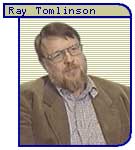 |
|||
 |
|||
![]() @ Work
@ Work
After the first IMPs were installed, including one at BBN, everyone was experimenting with doing things on the ARPAnet. Kleinrock and his students kept measuring its usage and occasionally pushed it to the breaking point to check for weaknesses. Researchers and students (including Bob Metcalfe) found several creative uses for the network, but Kleinrock's measurements indicated that the traffic didn't come close to filling the network's capacity. Something considered a frill would change that.
 Although initially looked upon as something improper for the ARPAnet,
electronic mail (email) was the first big hit on the network. People
could send messages to other people on a time-sharing computer before,
but now the researchers wanted to send messages between computers on
the ARPAnet.
Ray Tomlinson, an engineer at BBN,
wrote the first email
reader and writer for the ARPANET. He kept his program a secret and
just sent a message to himself to test it. However, his secret soon
got out and email was quickly passing across the ARPAnet. Kleinrock
reported that email took up more of the network's capacity than any
other application.
Although initially looked upon as something improper for the ARPAnet,
electronic mail (email) was the first big hit on the network. People
could send messages to other people on a time-sharing computer before,
but now the researchers wanted to send messages between computers on
the ARPAnet.
Ray Tomlinson, an engineer at BBN,
wrote the first email
reader and writer for the ARPANET. He kept his program a secret and
just sent a message to himself to test it. However, his secret soon
got out and email was quickly passing across the ARPAnet. Kleinrock
reported that email took up more of the network's capacity than any
other application.
When writing his email applications, one of the design problems Tomlinson had to tackle was how to address users on different computers. On a single computer, people could just send a message to a particular user name. But on the ARPAnet, there had to be a way to signify which computer computer hosted the account. Tomlinson decided to combine the account name with the computer name into a single address.
He looked at his keyboard for a single character to delimit the two names. One particular character made a lot of sense to him, because it wasn't used in proper names and the symbol meant "at". They character was the "@" symbol. Unfortunately, his choice for the most important character in Internet email addresses netted him zero profit.
![[map of early arpanet]](arpamap1.gif)
The Big Demo
After several more universities linked their computers to the ARPAnet,
Larry Roberts, now director of IPTO,
wanted to demonstrate the abilities of
the network to other research centers funded by ARPA and other
people in the young field of computer networking. He assigned
Bob Kahn at
BBN to organize the event and arrange for demonstrations showing off the
potential of the network. Kahn spent the year getting people and
equipment ready for the event to be held at the Hilton in Washington, D.C..
Bob Metcalfe had written a short guide to all the exhibits, but everything was so new that many people couldn't understand or believe some of the demonstrations. They watched demonstrators logging into computers across the country, running a program there, and then sending the output back to the Hilton. Almost everyone was very impressed.
AT&T, one of the early and strongest skeptics of packet-switching, attended assuming they would witness the failure of a pipe dream. Metcalfe, still a graduate student, volunteered to show them around and demonstrate a working ARPAnet. However, the demonstrator's nightmare occurred - the network crashed. It was the only time during the conference that it failed, but the AT&T businessmen took it as evidence that packet-switching was doomed.
Copyright © 1998, PBS Online,
Inc. All Rights Reserved.
Site Designed and Developed by
OPB Learning Media